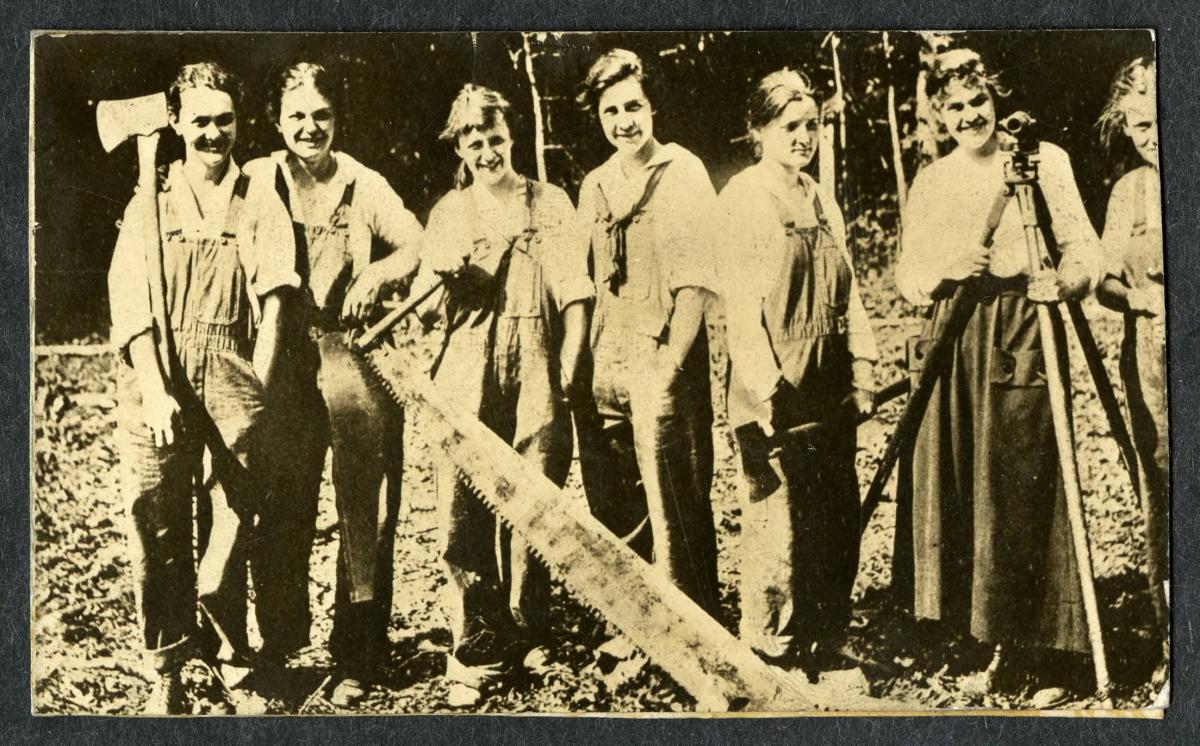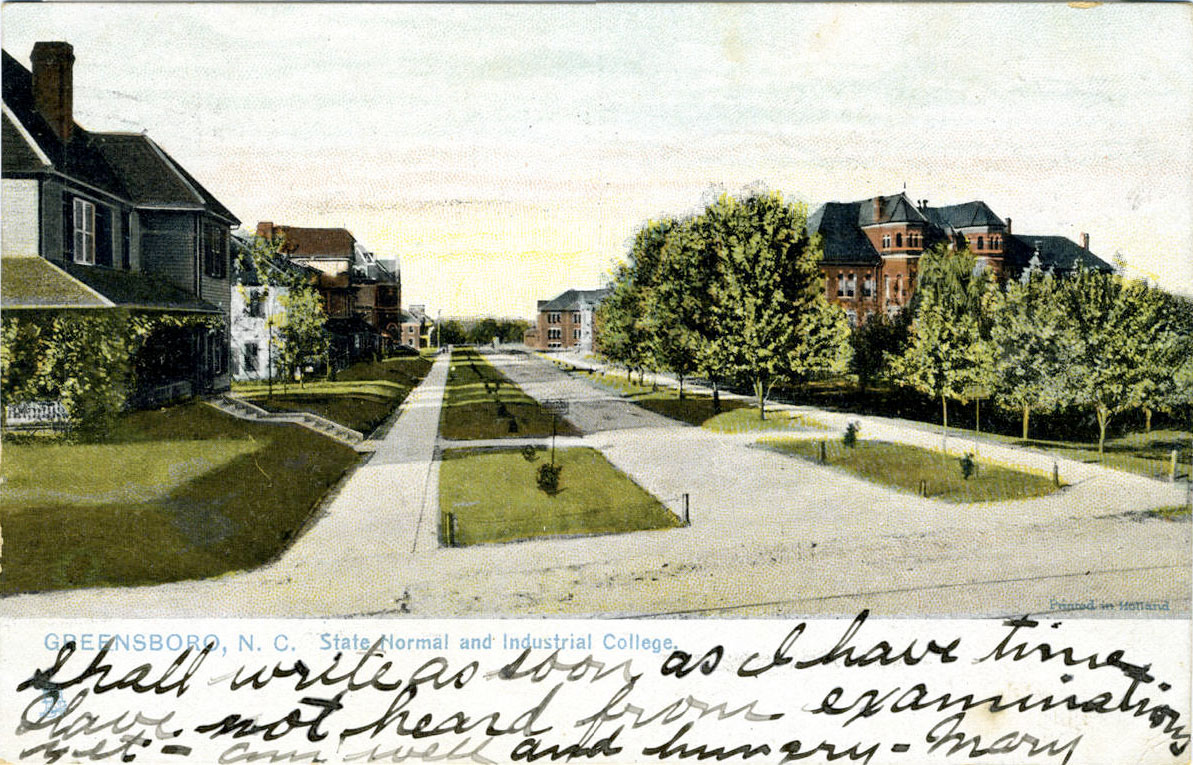In 1901, North Carolina had only one college for white women -- The State Normal and Industrial College. Today we know this college as UNC Greensboro. Below is an excerpt from the Student Handbook for 1901-1902 issued to incoming students to the State Normal and Industrial College of North Carolina.
State Normal and Industrial College.
Our College, located at Greensboro, was established by the General Assembly of 1891, and in October, 1892, its doors were first opened for the reception of students. The Institutions is a combination of a Normal College and an Industrial School. It is its general purpose to give such education as will meet the needs of the young women of North Carolina, whatever may be their fields of labor. To this end there are three distinct departments in the course of study. These are:
- The Normal"Normal" schools or departments were those for the training of teachers. Department
- The commercial Department.
- The Domestic Science Department.
All students should decide upon one of the regular courses of study leading to graduation.
Boarding Arrangements
There are now accommodations for 250 students in the dormitories. These students secure board at $8 per month. Board for other students may be secured in private families within a few hundred yards of the College buildings at from $10 to $11 a month. Students boarding in the dormitories will be under the direct care of the President, Lady Principal, and competent lady assistants. Students outside the dormitories are allowed to board only in such homes as are managed in sympathy with the government of the institution.
Equipment.
The institution is provided with a well selected Library, which is kept open from 9 a.m. till 5 p.m. daily; a Reading-Room containing the best current literature, including State and National newspapers, leading magazines and educational journals: a gymnasium equipped with apparatus for physical culture; scientific laboratories for Physics, Chemistry, Botany, Geology, etc., supplied with the Implements necessary for individual experiments and investigation.
Student’s Contract.
I do hereby contract with the State Normal and Industrial College, that so long as I shall remain a student of the Institution, I will endeavor to comply cheerfully with all its regulations in all particulars, and I agree not to deface or injure, by writing or otherwise, any of its furniture, books, or other property. Moreover, if I should accidentally do damage to any property of the institution I hereby agree to report it promptly to the President of the institution, or in case it should be dormitory property, I agree to report it to the lady in charge of the building where the damage is done, in order that it may be properly assessed and that I may pay for the same.
Annual Expense.
For tuition-paying students, with board in the dormitories, $130. For non-tuition-paying students, with board in dormitories, $90. Expenses of students boarding in private families will, on account of the different charges for board, exceed the above amounts by about fifteen dollars. No Student receives free tuition who does not sign a pledge to become a teacher in the public or private schools of the State. For students belonging to one of the Literary Societies, the annual fee is one dollar. There is generally a lawn-tennis club in school, the expenses of which are nominal. It is false economy for a student to deprive herself of the advantages to be gained from the College Lecture course, or other lectures and concerts recommended by the authorities of the institution. All these expenses will be covered by less than three dollars. Young women have such different ideas as to the amount necessary to spend on dress that it is hard to make a positive estimate in this particular. But as the rule, we may say that what you would wear at home you may wear here. The College discourages extravagant dressing on the part of students and teachers.
Hints to New Students.
You will be met at the train by some officer of the institution. Upon arriving at the dormitories, go immediately to the Lady Principal whom you will find in the brick dormitory. After she dismisses you, should you desire information on any point not already made clear, please feel at liberty to call upon any student who wears the Association’s badge = dark heliotrope and lavender colors. She will be glad to help you.
Be sure
- To be on time.
- To register as soon as possible after your arrival.
- To read the Registration Card before signing it.
- To call early upon the Bursar A bursar is someone who handles finances at a school or university and make your first payment.
- To report promptly to Chapel, on hearing the “long bell.”
- To watch the Bulletin Board.
- To understand that you are admitted to no class without examination on the work of lower classes.
- To report to the first examination offered on each subject that you must pass, and thus save time and trouble.
- To make out your Schedule of Recitations as early as possible.
- To call on the old students for the necessary help.
- To ask all necessary and leave unasked all unnecessary questions.
- To remember that the wants of each of four hundred students cannot be attended to at once.
- To await your turn patiently.
- To decide upon a regular course of study.
- To read the Library Regulations.
- To observe them
- To be helpful and earnest
- To take plenty of exercise.
- To remember that the advice of a friendly teacher as to the amount of work you can do is worth something.
- To be courteous to your inferiors, without unpleasantly patronizing them.
- To join the Athletic Association.
- To have a pocket in your school dress.
- To read the school catalogue through once.
- To keep this little Hand-Book.
- To begin right at school, remembering that what you make of yourself in College, you will be all your life.
Course of study
I.
Freshman.
- Algebra 4 credit hours
- English 4 credit hours
- French or German 5 credit hours
- Physical Geography and Botany 3 credit hours
- English History 2 credit hours
- Drawing 2 credit hours
- Vocal Music 2 credit hours
- Physical Culture 2 credit hours
Sophomore.
- Geometry 4 credit hours
- English 3 credit hours
- Latin, French or German 4 credit hours
- Chemistry 5 credit hours
- General History 2 credit hours
- Reading 1 credit hours
- Vocal Music 1 credit hours
- Drawing 2 credit hours
- Physical Culture 2 credit hours
Junior.
- Trigonometry or history 3 credit hours
- English 3 credit hours
- Physics, or Architectural Drawing 5 credit hours
- Psychology 3 credit hours
- Music, Elocution, Civics 3 credit hours
Senior.
- English 3 credit hours
- Latin, French or German 3 credit hours
- Review 2 credit hours
- Pedagogies (with practice) 7 credit hours
- Geology, Zoology, Mathematics or Architectural Drawing 4 credit hours
- Elocution 1 credit hours
- Physiology 3 credit hours
II
Freshman.
- Algebra 4 credit hours
- Latin, French or German 5 credit hours
- Physical Geography and Botany 3 credit hours
- English History 2 credit hours
- Drawing 2 credit hours
- Vocal Music 2 credit hours
- Physical Culture 2 credit hours
Sophomore.
- Geometry 4 credit hours
- English 4 credit hours
- Latin, French or German 4 credit hours
- Chemistry 5 credit hours
- Reading 1 credit hours
- General History 2 credit hours
- Sewing 2 credit hours
- Physical Culture 2 credit hours
Junior.
- Psychology 3 credit hours
- English 3 credit hours
- Latin, French or German 5 credit hours
- Physics 3 credit hours
- Civics -3 and Elocution – 2 2½ credit hours
- Cutting and Fitting – 3, Cooking 1 – 3 ½ credit hours
Senior.
- Pedagogies (with practice) 7 credit hours
- English 3 credit hours
- Latin, French or German 3 credit hours
- Physiology 3 credit hours
- Elocution 1 credit hours
- Review 2 credit hours
- Dressmaking – 1, Household Economics – 2 4 credit hours
Primary Source Citation:
The State Normal and Industrial College of North Carolina. Students' Handbook for 1901-1902. Greensboro: J.M. Reece & Co, Book and Job Printers, 1901. Martha Blakeney Hodges Special Collections and University Archives, UNCG University Libraries, Greensboro, N.C. http://libcdm1.uncg.edu/cdm/ref/collection/Carolinian/id/29554/rec/1



